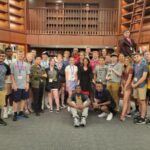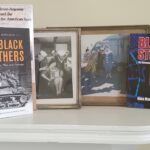Radio Show
Author Gina DiNicolo discusses THE BLACK PANTHERS AT WAR ON #ConversationsLIVE
Interview:
A Conversation with Gina Maria DiNicolo Author of The Black Panthers: A Story of Race, War and Courage. The 761st Tank Battalion in World War II and Blood Stripe: The Susanna Marcasi Chronicles.
Transcript:
Bookpleasures.com welcomes as our guest military historian, as well as an award-winning journalist and author Gina Maria DiNicolo. Gina is the author of nonfiction The Black Panthers: A Story of Race, War and Courage. The 761st Tank Battalion in World War II and Blood Stripe: The Susanna Marcasi Chronicles, a fictional tale of suspense.
Gina has written on military topics for nearly two decades. She was also a contributing editor at Military Officer Magazine, where more than twenty of her stories graced the publication’s cover. She is a graduate of the U.S. Naval Academy with a degree in history, and served as an officer in the Marine Corps.
Gina: Norm, thank you for having me. I have been writing mostly on history since my undergraduate years at the Naval Academy. After graduation, while serving as a Marine Corps officer, I wrote here and there on defense, but in 1998, I got my real start as a defense writer for a national veterans’ magazine,Military Officer. I created its blog and wrote as a paid defense blogger. I also penned more complex defense articles for the magazine.
Variety keeps me going and something struck me around 2010: It was time to move to writing books. Growth and telling a good story also keep me moving forward. If I get a hold of a great story idea, I will work almost nonstop to bring it to publication.
Gina: I have been fortunate to write what interests me. That interest keeps me focused. Some might say I remain obsessed and hungry for more and accurate information. I read my drafts to improve the manuscript, but as any writer knows, that only goes so far. There is no substitute for a good substantive editor. Once published, I don’t read my work. Writing is very emotional and private for me. Sending the manuscript to the publisher signals the end of an intimate relationship with my characters. I mourn and move on to the next work.
Gina: I don’t read on how to write, but I recommend Stephen King’s On Writing: A Memoir of the Craft. It is more philosophical than technical, and it is an exquisite work.
I learn about writing from reading and studying other authors. I learned about nonfiction story telling from Erik Larson and his works of narrative nonfiction. I have learned by studying the writings of military historians like Stephen Ambrose and other historians like Doris Kearns Goodwin. I learn by writing every day. One may look up a certain writing convention, but improved writing comes through doing.
Outline? I keep my plan in my head. I know I need a beginning, middle, and end, a climax and tension all put together to enthrall the reader. I know what I want, and I research and write. With the nonfiction Black Panthers: A Story of Race, War, and Courage, despite prior knowledge of the topic, I did not know where I’d begin and end the book. I was unsure of the climax. But I knew I wanted to tell the story of the 761st Tank Battalion as a unit and as individuals. I wanted to recount the larger story of the Army, Washington, and a world on fire. I had to see where the primary sources would take me. There is no outline for the way I work.
With Blood Stripe, the fictional thriller, I had ideas, but did not know where I wanted the story to go. I wrote more than 137,000 words to get the 91,000 that leave the reader breathless. This book was more like a sculpture. I left my options open. An outline would have been pointless in this case. But I have considered an outline for a possible upcoming nonfiction work because I have a better idea of the elements I want in the narrative. I am writing the second Susanna Marcasi book, again with a vague storyboard in my head.
Gina: I was fortunate to have brilliant teachers in Catholic primary and secondary school demanding perfection. I found the same at the academy. My work ethic comes from those years as well as my time in the Marine Corps.
My Style? I suppose I have a style. My style is narrative nonfiction, and I have found it carries over to my fiction. In nonfiction, I compose detailed back stories and layered characters. I weave complex elements. I write stand-alone chapters that can be rearranged with ease. I add the bizarre and shocking to entertain the reader. I use humor even in the bleakest moments. I present over-the-top characters and plots, but I try to ensure readers can relate to these characters as they would the guy next door.
Gina: Blood Stripe has been with me for 7 years, interrupted by the research and writing of Black Panthers. Several issues came together in Blood Stripe. I had long wanted to write about my period at the Naval Academy in the early 1980s and my follow-on years in the Marine Corps. I wanted to touch on the marginalization of women, specifically sexual assault and gender bias—but no one wants to read the nonfiction version of that tale.
At the same time, I had a friend secretly involved with a member of Congress. I was his confidante and learned more about the pair than I ever cared to know. I told my friend I planned to write their story as fiction. This person agreed. But, it was the Susanna Marcasi character that took off. With her came the links to the Naval Academy and Marine Corps and the unflattering secrets I wanted to reveal. Blood Stripe can be read as the thriller it is or for the metaphors that address deeper issues.
Gina: As I mentioned, I had a friend in a relationship with someone on the Hill. The settings are real – Memorial Bridge, Arlington Cemetery, New Orleans; much is described as it stands today – or did in 2000. Much of the book is realistic. Suicide, PTSD, corruption, assault, abuse of power. I pull from my experiences and those of others. Some are accurate, others are embellished. The diabolical plot? Plausible but not factual. Do Marines beat women with pipes? Technically no, metaphorically, maybe.
Gina: When I spend countless hours immersed with these characters, each one will take on a bit of me.
The characters are composites of people I know, have seen, and have created. There is a bit of me in several, especially Susanna Marcasi, Manfred Stahl, and police chief Roscoe Russell.
Gina: Characters grow like people grow. Events impact characters, Characters impact events. Characters change and evolve through the writing process. Lori and Joe, based on real people, were much stronger when I started, but Susanna took over. She had the bigger story. Higher stakes. More to lose. Stahl? As I learned how evil Stahl really was, his character grew more outrageous. The writing process builds the characters. I find I have to go back and rewrite a character to plot him or her to where I have gotten the person in the story. I give the main characters an arc. It takes draft after draft to layer and map these characters into 3-D powerhouses.
Gina: The most difficult part of writing a book is cutting this lengthy (but wonderful) exposition I have written. I love back stories, but they drive my editor crazy. They can adversely impact the action and the progress of the story. I find it hard to cut information. A second challenge is keeping that tension on every page. Also, there is a love story in Blood Stripe, but I did not want this to lapse into romance. It doesn’t. There is a love story in Black Panthers, and it remains a war story.
Gina: First, I like writing violence. Second, I learned about my past. I also found I am bothered more about gender bias than I thought. This book is no political or social statement. It is an entertaining thriller. But issues are touched upon metaphorically.
Gina: I hear from the readers on the 761st Tank Battalion through FaceBook and email. They seem thrilled as well as grateful for an accurate history that reads like a novel. I also get detailed questions from other writers about the unit.
Blood Stripe. Early reaction from those who know the academy is, Wow, that was dead on. It was like I was there. In fact in both books, readers say they felt they were in the middle of the action.
Gina: My WEB SITE
There are three FaceBook pages.
The Black Panthers, 761st Tank Battalion Page
Blood Stripe
My Author Page Gina Maria DiNicolo
I am also happy to make appearances and participate in interviews.
Also, Blood Stripe: The Susanna Marcasi Chronicles is available beginning November 10 on Amazon and others,
The Black Panthers: A Story of Race, War and Courage is currently available at many outlets including Amazon
Gina: A lot. The second book in the Susanna Marcasi Chronicles series is moving along. It takes place on September 11, 2001. A wedding. Saudi Arabia. Everyone’s invited. A third book about her academy years and a fourth placing her in Iraq are planned. Susanna’s Blood Stripe blog entries may come out as e-books soon.
Nonfiction. Currently, I am editing a series on the Iraq war. I also am in the query phase on several historical topics for my next narrative nonfiction.
Gina: I am asked about writing both fiction and nonfiction as a military historian. My response is story telling is story telling. The research may vary, but good writing is good writing. Writers can craft what they want if the topic interests them and if there is a market. Writing takes work. I tell people to more than learn their craft. If they can become their craft, they can write anything.
Gina: Thank You



